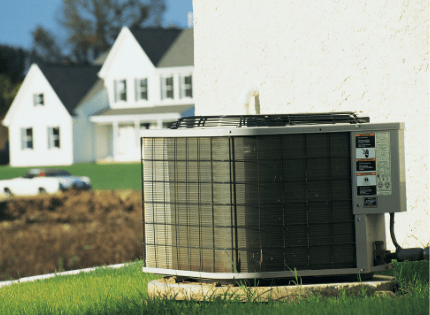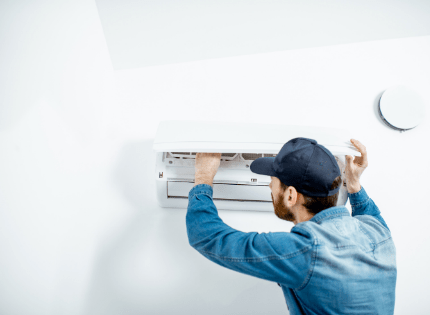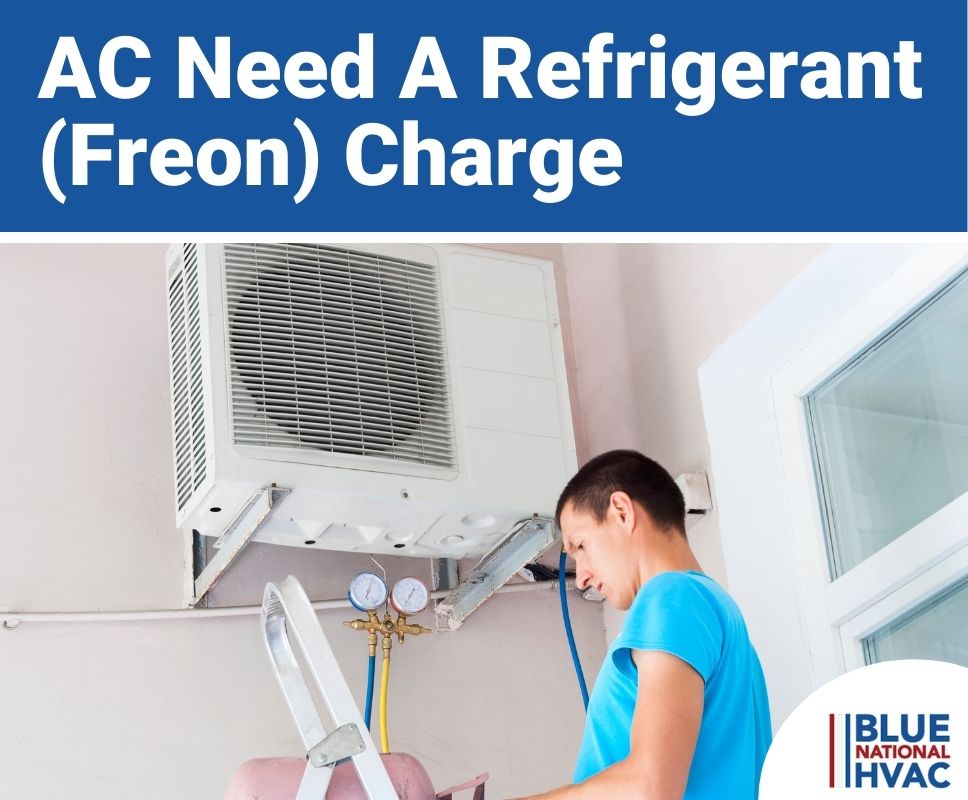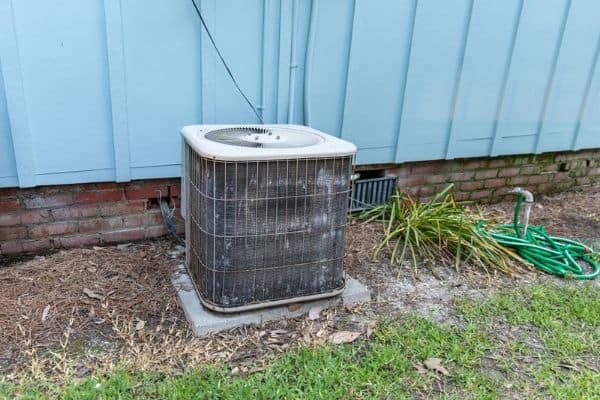What Makes an HVAC System the Best?
HVAC stands for heating, ventilation, and air conditioning. As such, any HVAC system either cools or heats your home – some even do both. HVAC systems include heating units such as natural gas furnaces, propane furnaces, electric furnaces, and boilers.
They include cooling systems too – central air conditioners, window AC units, and portable air conditioners. Additionally, heat pumps round out the types of common residential HVAC systems and provide both heating and cooling. Heat pumps include air-source, ductless mini-split, geothermal, and water-source units.
The main factors that we use to determine the best HVAC systems are quality, lifespan, serviceability, high-efficiency options, location, warranty, and the additional features and options available.
Quality
An HVAC system’s outstanding quality and durability will reduce the likelihood of the unit failing many years after its initial installation (assuming the homeowner arranges proper routine maintenance). The best HVAC systems out there rarely require significant repairs (beyond routine tune-ups) which means you can rely on them for decades to come.
Serviceability and Parts Availability
Having top quality isn’t everything, however. The fact is, even the HVAC systems with the utmost quality still require some service and repairs during their lifetime. With a high-quality HVAC system, the chance of needing a repair within the first seven years after installation is low – less than 15%. But, maintenance and tune-ups are still required yearly.
The ease of service plays a big factor in the labor rates you pay for a one-time service visit from an HVAC technician. For example, if your HVAC system takes the technician 1.5 hours compared to 1 hour for a different unit, you’ll be paying a 50% higher price for labor.
Additionally, manufacturers that use non-exclusive, common components in their HVAC systems cause far fewer headaches than ones with hard-to-find replacement parts.
If your furnace were to fail in the dead of winter, your repair would be much faster (same day) if the replacement component is in stock locally. On the other hand, if it is not stocked nearby, you may have to wait 1-3 days or potentially over a week to get your furnace back up and running. In the latter scenario, you probably wouldn’t consider your HVAC system the “best” simply due to the length of time it took to repair.
Lifespan
Another significant factor that is common amongst the top HVAC units is their long lifespan. Put simply, HVAC systems that last a long time provide a better value to the homeowner.
As you can imagine, replacing an HVAC system every 5 to 10 years would be much more costly in the long run than replacing it every 20 to 30 years.
High-Efficiency Options
When comparing HVAC systems, the best brands have high-efficiency models available. The efficiency of an HVAC system is the ratio of its cooling or heating output versus the energy it uses, either electricity or fossil fuels.
The efficiencies of all HVAC systems follow this same premise, albeit they are determined differently and have different units of measure
Here is how the efficiencies of standard HVAC systems are measured:
- Air conditioner – Seasonal Energy Efficiency Ratio (SEER), the measure of cooling efficiency throughout the entire cooling season
- Boilers & Furnaces – Annual Fuel Utilization Efficiency (AFUE), the measure of heat created versus the fuel combusted over an entire year of operation
- Heat pumps – Seasonal Coefficient of Performance (SCOP), the ratio of useful cooling or heating to the power used over the entire season (heat pumps sometimes have SEER ratings too)
All top of the line brands have a high energy efficiency rating, low energy costs, and models with excellent energy star ratings (for example, a high SEER rating).
Location
Your home’s geographic location is essential to what the “best” HVAC system is for you. For example, homes in Arizona have vastly different climates than homes in Minnesota. Therefore, the HVAC systems installed in these areas are often different.
In fact, the U.S. Department of Energy Building America program divides the U.S. into six basic climate zones to help HVAC professionals determine the best practices and HVAC systems for each region.
Most climate zones are determined by a measurement of “degree days.” A degree day is the difference between the actual temperature and the average temperature over an entire day with a set base temperature of 65°F (25°C). As an example, let’s say February 17th is an average of only 20°F, then its heating degree days are measured as 45 (or 65 minus 20).
Here are the six Building America program climate zones:
Marine Climate Zone
The marine climate zone is a relatively small geographical region comprising the coastal areas of Washington, Oregon, and a large portion of coastal California. The marine region is defined as meeting the following:
- Hottest month with a mean temperature of no greater than 72°F (22°C)
- Coldest month with mean temperatures between 27 to 65°F (-3 to 18°C)
- Contains at the minimum four months with mean temperatures higher than 50°F (10°C)
- Summers are relatively dry, and the cold season has the majority of the precipitation (the cold season is defined as October through March in the U.S. by the Department of Energy (DOE)
Hot-Dry / Mixed-Dry Zone
Hot and dry climate regions get less than 20 inches of rain in a year and have an average temperature no lower than 45°F (7°C) every month of the year.
A mixed-dry climate zone is an area that also gets less than 20 inches of rain each year, has an average temperature of less than 45°F (7°C) during the cold months, and has under 5,400 heating degree days.
The hot-dry climate zone in the U.S. is composed of parts of western Texas, southern New Mexico, Arizona, and most of the non-coastal region of California.
Hot-Humid Zone
A hot-humid zone is a regional area that gets higher than 20 inches of rainfall in a year and where at least one of the following happens: (1) a 67°F (19.5°C) or larger wet bulb temperature for more than 3,000 hours or (2) a 73°F (23°C) or higher wet bulb temperature for more than 1,500 hours during the warmest consecutive six months of the year.
The hot-humid climate zone in the United States is located mainly around the Gulf of Mexico – Florida, southern Georgia, Mississippi, Alabama, eastern Texas, Louisiana, and parts of South Carolina.
Mixed-Humid Zone
Like other climate zones, the mixed-humid region receives more than 20 inches of rain in a year. However, it is also defined as having at most 5,400 heating degree days where the average temperature is lower than 45°F (7°C) in the cold months.
In the United States, the mixed-humid climate zone is composed of most of the midwest from Kansas to the east coast, bordered by the hot-humid zone in the south and Indiana/Illinois to the north.
Cold / Very Cold Zone
A cold climate zone is a geographic area that has from 5,400 to 9,00 heating degree days (with 65°F as the basis). On the other hand, a “very cold” zone has 9,000 to 12,600 heating degree days.
Sub-Artic Zone
A subarctic climate zone is defined as a region with over 12,600 heating degrees days with a 65°F basis. The only area in the United States that falls into this climate zone is the state of Alaska.
Warranty
The level of warranty is a significant factor in determining the ranking of any HVAC system. Warranties for HVAC units come from manufacturers, such as Carrier, Trane, Lennox, Rheem, etc.
The top manufacturers offer industry-leading equipment warranties because they are confident with the quality of their equipment and to remain competitive with other brands.
Warranties should be an essential consideration for homeowners too. If a repair is covered under warranty, that means you don’t have to pay for it. Here is what excellent warranty terms look like:
- Parts warranty – between 5 to 10 years
- Compressors – over 20 years or lifetime
- Heat exchanges – over 20 years or lifetime
- Warranty is transferable
Many manufacturers have warranty registration periods that need to be completed by the homeowner within 60 to 90 days after installation. If they fail to register, the warranty terms will be reduced. For example, a 20-year warranty can become a ten-year one. Therefore, this is an important consideration to keep in mind when purchasing a new HVAC system.
Wide Selection of Features and Options
All the best HVAC brands have a plethora of features and value-add options available on their HVAC equipment. This means they have the full gambit of product lines, from mid-efficiency to ultra-high-efficiency HVAC units.
In addition, they have optional features such as variable-speed fans, humidity control communicating technologies (2-way communication), smart thermostats, and more. In other words, the top HVAC manufacturers provide HVAC units for all climate zones and levels of consumers.
The Best HVAC Systems
HVAC systems are necessary for keeping your home warm in the winter and cool in the summer. To get the best and most efficient performance for your home, all homeowners should know the best systems for their climate zone.
Below, you’ll find the most common HVAC systems, what climate zones they perform the best in, and what the top manufacturers are of each type.
Central Air Conditioners
Central air conditioners include an indoor and outdoor unit that works together to remove heat from a home and circulate cool air. Central AC units work by utilizing the vapor-compression refrigeration cycle to cool homes.

An AC system has four major components that operate in a closed-loop, connected with refrigerant lines:
Compressor
Vapor refrigerant is pulled through the compressor and compressed to a higher pressure which heats the vapor too. The heated vapor is then pumped to the condenser unit.
Condenser
When the heated refrigerant enters the condenser, it’s pumped through the coils of the outdoor unit. It is then cooled by airflow across the coils. A large portion of the heat is removed from the vapor refrigerant; it then moves along the closed-loop to the thermal expansion valve.
Thermal Expansion Valve
The next step the refrigerant vapor hits in the closed-loop system of the vapor-compression refrigeration cycle is the thermal expansion valve. The thermal expansion valve provides a quick reduction in pressure by allowing the gas to lower in temperature rapidly.
Now that the refrigerant is cool, it moves to the evaporator in the indoor unit.
Evaporator
When the cooled refrigerant enters the evaporator, it is pumped throughout the coils. An internal blower then blows warm air from inside the home across the coils. As the warm air passes through the coils, the cool refrigerant removes heat from the air.
When the heat is removed from the hot air, the moisture held within it condenses onto the coils and drains into the condensate drip pan.
The now cold air is blown back throughout the home through the ductwork, and the warm refrigerant (which took the heat out of the air) is pumped back to the outdoor unit and compressor, and the cycle is repeated until the setpoint on the thermostat is reached.
Climate Zone
Central air conditioners work best in the majority of climate zones. Here are the ones they work the best in:
- Mixed-humid – Central AC units are often paired with furnaces to provide heating and cooling to homes throughout the year
- Hot-dry and mixed-dry – Central AC units are often the sole HVAC system in these climate zones
- Cold and very cold – although these climate regions are classified as “cold,” anyone from these areas can attest to the scorching hot summers that necessitate a central air conditioning system
Advantages and Disadvantages of Central Air Conditioners
| Advantage | Disadvantage |
| Reduces humidity in the home | Ductwork is required, which is expensive to install |
| Cools the entire home | Higher energy bills during the hottest months |
| Increase the home’s value | The outdoor unit can be loud |
| An efficient method of cooling | Risk of refrigerant leaks |
Top AC Unit Brands
Here are the best central air conditioner brands:
- Carrier
- Trane
- Goodman
- Ruud
- Bryant
All of these manufacturers have outstanding quality, serviceability, long lifespans, and competitive pricing. In addition, they have various models from 13 SEER up to 26 SEER available.
Best Window AC Units
Window AC units are conveniently designed to fit into most windows. They are fantastic solutions for homeowners that wish to only cool a single room. They range in size, cooling output, and efficiency.
Window air conditioning units work by using the same core process as central air conditioners, the vapor compression refrigerant cycle. However, unlike central air conditioners, each critical component is more compact, with all parts fitting into the single chassis that mounts in the window.
Climate Zone
Like central air conditioners, window AC units are great solutions for mixed-humid, hot-dry/mixed-dry, and cold/very cold climate zones. However, due to their compact and affordable nature, they are also helpful in the marine and hot-humid climate zones for supplemental cooling of one room.
Advantages and Disadvantages of Window Air Conditioners
| Advantage | Disadvantage |
| Affordable | Requires removal/installation into window seasonally in some areas |
| Cools only one room, reducing the energy bill | If more than one room needs cooling, you need multiple units |
| Easy to clean | Can be an “eyesore” to some homeowners from exterior |
| Doesn’t require ductwork | Blocks view out of the window |
Top Window AC Brands
The top five window AC unit manufacturers are:
- LG
- Kenmore
- GE
- Frigidaire
- Haier
These top dogs make high-efficiency window AC units that provide great cooling capacities (measured in BTU or tons), tremendous warranties, easy cleaning, and affordability.
Additionally, the installation of their window AC units is simple and can easily be managed by most homeowners.
Best Portable AC Units
Portable AC units are similar to window AC units in that they contain all the components in a single, compact device and are designed to cool single rooms.
Portable AC units are generally in the shape of a small, hip-height filing cabinet. And like filing cabinets, they are also on wheels for easy transport. They are designed to sit next to a window and exhaust through an aluminum tube (similar to a laundry dryer).
Climate Zone
Portable AC units are helpful in the same climate zones as window air conditioners – mixed-humid, hot-dry/mixed-dry, cold/very cold, marine, and hot-humid climate zones.
Advantages and Disadvantages of Portable Air Conditioners
| Advantage | Disadvantage |
| Affordable | The vent pipe is very hot to touch |
| Cools only one room, reducing the energy bill | If more than one room needs cooling, you need multiple units |
| Easy to clean | Takes up floor space |
| Doesn’t require ductwork | Blocks view out of the window |
| Easy to install, doesn’t block the view from the window | Difficult to roll on carpet |
Top Portable AC Brands
The top five portable air conditioner brands are:
- Honeywell
- Frigidaire
- Whynter
- LG
- Black + Decker
These manufacturers design capable and convenient portable air conditioners. They are not only super energy efficient, but they do have a sleek, modern look and they will get the job done.
These portable AC units can be easily vented through a window, taking up no more than 6-8” of clearance. Lastly, they all have tremendous equipment warranties which is great for driving down repair costs.
Best Natural Gas Furnaces
Gas furnaces heat homes by combusting natural gas and exchanger the heat created with the air before blowing it into the house via ductwork. Natural gas furnaces are composed of an indoor unit that contains a burner, heat exchanger, blower, a flue to exhaust the combustion gas, and an air filtering system.
High-efficiency natural gas furnaces have secondary heat exchangers that remove even more heat from the combustion gas before it is exhausted through the flue to the outdoors.
Natural gas furnaces are highly robust and have high-efficiency options up to 98.5% AFUE. A natural gas furnace can easily be converted to a propane furnace with a conversion kit.
Climate Zone
Gas furnaces are best suited for climates with cold winters due to their ability to produce a lot of heat quickly. Here are the climate zones that gas furnaces are best suited for:
- Cold/very cold
- Mixed-humid
- Subarctic
Advantages and Disadvantages of Gas Furnaces
| Advantage | Disadvantage |
| High energy efficiency | Only provides heating (and not cooling too) |
| Easy repairs and maintenance | Bigger indoor footprint |
| In some climates, an AC unit may be unnecessary | Blower and air handler can be loud |
| Large heating capacity | Directly uses fossil fuels |
| Fast response to heating demands | Carbon monoxide and gas leak risks |
Top Gas Furnace Brands
The top five natural gas furnace brands are:
- Amana
- American Standard
- Carrier
- Daikin
- Trane
All five manufacturers offer excellent equipment warranties, efficient models with greater than 98% AFUE, and various heating stages – single-stage, two-stage, and variable-capacity units.
Best Electric Furnaces
Electric furnaces are entirely electronic, which means they never burn fossil fuels to create heat. Instead, they are designed with electric heating elements to convert electrical energy to heat.
Once the heating elements are warm, the blower moves air across them and pumps it through the home via ductwork. At the same time, the cooler air in the rooms is sucked through the return vents, and the heating process repeats until the temperature reaches the thermostat’s setpoint.
Climate Zone
Unlike gas furnaces, electronic furnaces struggle to keep up with the high heating demands of cold weather. Therefore, they are best for the following climate zones:
- Mixed-humid
- Marine
- Hot-humid
Advantages and Disadvantages of Electric Furnaces
| Advantages | Disadvantages |
| Easier installation | Poor performance in colder climates |
| Simple maintenance | High energy consumption and costs, especially on frigid days |
| Long lifespan | Slow heating response time |
| No risk of carbon monoxide or natural gas leaks | Replacement parts are harder to source |
| Exceptional efficiency rating | Uses lots of electricity to heat a home |
| Great for small homes | Uses electricity generated by local power plants, which may have more harmful emissions than gas furnaces |
Top Electric Furnace Brands
The top five electric furnace manufacturers are:
- Goodman
- Revolv
- Blueridge
- Winchester
- Alpine
Electric furnaces from these top five manufacturers have industry-leading efficiencies, quiet operation, easy maintenance, and simple installation.
Best Air-Source Heat Pumps
Air-source heat pumps look nearly identical to central air conditioners and work similarly to them too. However, they include one crucial design change that allows them to cool and heat homes – the reversing valve.
Remember how central air conditioners use the vapor compression refrigeration cycle to remove heat from a home? The reversing valve enables the heat pump to run the process backward, remove heat from the outside air, and pump the heat into the house.
This works because even frigid air still contains heat unless it’s at absolute zero – about –459.67°F, which thankfully is impossible on Earth.
Climate Zone
The best climate zones for air-source heat pumps include all geographic areas that don’t get “super cold” during the winter months. Here are the best climate zones air-source heat pumps:
- Hot-humid
- Mixed-humid
- Hot-dry and mixed-dry
- Marine
In recent years, heat pumps have undergone vast efficiency improvements. In fact, some high-end models can even be used in areas with sub-zero temperatures and still efficiently heat home. Therefore, some air-source heat pumps are great for the cold and very cold climate zones.
Advantages and Disadvantages of Air-source Heat Pumps
| Advantage | Disadvantage |
| High efficiency with outdoor temperatures above 30°F | Risk of refrigerant leaks |
| Small indoor footprint | During rare, super cold spells, supplemental heating might be necessary |
| Provides heating and cooling from a single HVAC system | More frequent maintenance since they run most of the year for cooling and heating |
| Absolutely zero risks of gas and carbon monoxide leaks | Costly repairs and maintenance |
| Fantastic energy efficiencies | Larger energy bills on scorching and freezing months |
| Easy maintenance | The outdoor unit can be loud |
Top Air-Source Heat Pump Brands
The top five heat pump manufacturers include:
- Heil
- Lennox
- York
- Carrier
- Comfortmaker
All five of these brands have mid to high-efficiency systems, various blower motor speeds, and plenty of cooling capacity sizes for any sized home.
Best Ductless Mini-Split Heat Pumps
Ductless mini-split heat pumps function the same way as air-source heat pumps. However, their indoor units are mounted directly on the wall of the rooms they heat and cool. As such, they do not require ductwork, but they are limited to conditioning only a single room or zone.

Like air-source heat pumps, ductless mini-split systems have indoor and outdoor units. However, multiple indoor units can be connected to a single outdoor unit for temperature control of additional zones.
They are one of the most efficient HVAC systems, partly because their indoor unit is directly installed in the space they are conditioning; no heating or cooling can be lost when transferred through ductwork.
Climate Zone
The best climate zones for ductless mini-split heat pumps include the same climate zones as air-source heat pumps:
- Hot-humid
- Mixed-humid
- Hot-dry and mixed-dry
- Marine
Like air-source heat pumps, some high-efficiency models can efficiently heat homes in cold and very cold climate zones.
Advantages and Disadvantages of Ductless Mini-Splits
| Advantage | Disadvantage |
| High efficiency in moderate outdoor temperatures | Risk of refrigerant leaks |
| Minimal indoor footprint (mounts high up on a wall) | During rare, super cold spells, supplemental heating might be necessary |
| Provides both heating and cooling from a single HVAC system | More frequent maintenance |
| Absolutely zero risks of gas and carbon monoxide leaks | Costly repairs and maintenance |
| Fantastic energy efficiencies | Larger energy bills on very hot and very cold months |
| No ductwork required | If multiple zone control is needed, it can get expensive |
Top Ductless Mini-Split Heat Pump Brands
Here are the top brands of ductless mini-split heat pumps:
- LG
- Mitsubishi
- Daikin
- Fujitsu
- Blueridge
All five of these manufacturers have models that can control one zone to six or more zones. Each one has fantastic quality and performance as well as multiple capacity sizes to accommodate any size space.
Why HVAC Installation is Important
Even if you get the best HVAC system for your home, that means nothing if it is installed incorrectly. We’ve provided the top 5 brands of the most common types of HVAC systems, and if installed correctly, all of them will run efficiently and will have amazingly long lifespans.
If installations are done wrong, the equipment can break down and lead to costly repairs. In the worst-case scenario, the HVAC system will have to be entirely replaced just after a few years (or less) of operation.
That is why it is vital to hire experienced and skilled HVAC contractors to install any new HVAC system. Give our seasoned installers a call today if you need assistance with your HVAC system.
How to Choose the Best HVAC System for Your Home
Choosing the best HVAC system for your home depends on many variables. These include:
- Your climate zone
- The size of your home
- Your budget and price range
- Whether your home has ductwork or not
In general, air-source heat pumps are best for the southern US and homes with existing ductwork. Air conditioners and gas furnaces are great for the northern states. Lastly, electric furnaces, window AC units, and portable air conditioners are best for small homes, and if you’re on a budget and don’t have ductwork, ductless mini-split systems are a great alternative.









